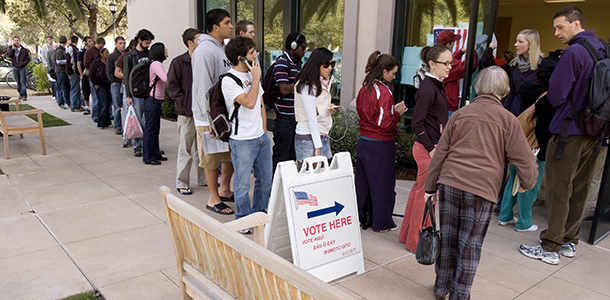
(Photo Credit: Josh Thompson/Flickr)
Who pays for California elections? While much is known about the contributors and costs of political campaigns, very little is known or well-understood about how the election process itself is funded.
The costs of administering elections in California – costs such as printing ballots, hiring, training and paying pollworkers, printing and mailing ballots and ballot pamphlets, tabulating votes and verifying results – are covered primarily by local government. County governments facilitate elections for federal, state and most local contests. Cities in California either administer their own elections, or reimburse counties for the cost of administering them.
Unlike cities, other levels of government do not reimburse counties for the cost of facilitating their elections. Although federal and state offices take up a considerable amount of real estate on the ballot, neither the federal nor state government contribute any funds directly toward the cost of elections.
The state and federal governments did make a significant investment in new voting equipment in 2002. And recently there’s been more discussion about potential new state investments. Here are ten things California should do to modernize our elections and increase voter turnout:
1. Don’t repeat what we did the last time. In 2002 the state and federal government appropriated nearly 400 million to purchase voting equipment – counties had to put up matching funds as well. A lot of that equipment ended up being taken out of service due to certification and security problems.
At the time this procurement took place there was little to no infrastructure at the state or federal level to test and certify equipment. Equipment was purchased before new standards were put in place. Following widespread technological problems in the March 2004 Presidential Primary election when voters in half of San Diego county’s polling places were literally told to go home and try to vote later, the legislature enacted a voter verified paper audit trail requirement, resulting in 40,000 touchscreens replaced with optical scan systems or retrofitted with printers by the following 2006 Primary election. We should also avoid having 58 counties operating as independent customers to a handful of vendors, negotiating 58 unique contracts for goods and services.
2. Build the Secretary of State’s infrastructure to support modernized elections. Provide funding for staff to support the development of regulations and testing of voting-related equipment. Make sure technical support staff are well-compensated so we don’t lose them to the private sector.
3. Include ALL technology in the concept of “voting systems” – not just the machines used to cast or tabulate ballots, or epollbooks and ballot on demand printers, but also the election management system, online assistance and services, mail ballot sorting machines and especially technology used to verify signatures on mail ballot envelopes.
4. Fund the Secretary of State to provide technical support to counties. Don’t leave the 58 counties on their own to deal with their technology challenges. The Secretary of State can and should operate as a clearinghouse of information about all voting-related equipment in the state and provide on-site support and consultation, especially in counties where tech support is a challenge.
5. Provide ongoing, direct support for elections such as block grants to counties with fiscal incentives to increase participation or a funding scheme where counties could bill the state government for its portion of ballot space taken up by state contests, as they currently do with cities. A state funding approach could be modeled after the K-12 Local Control Funding Formula, taking into account not only the number of eligible and participating voters but also language and accessibility needs. Build in requirements for reporting by counties to the state, on topics such as rejected mail ballot rates, web site usage and election verification results.
6. Also provide money to counties for signature verification for state ballot initiatives and for special election costs.
7. Consider the advantages to voters in creating more uniformity in our voting systems. For example, consider sending everyone a ballot and have the state cover the costs and then allow counties to vary in the options by which it can be returned.
8. Pay for ballot postage. The Legislature created the laws that allow permanent, no-excuse absentee voting. As this has become a more popular voting method, the state and counties should factor in postage costs to ensure having a postage stamp on hand or knowing the exact amount of postage to require are not barriers to casting a ballot.
9. Support online voting information. We need to shift from a paper to digital framework and ensure that when voters use their smartphones to access official voting information, they find it. The state is already working collaboratively with counties to implement sample ballot lookup tools statewide. This work should continue and be expressly supported in a state election funding plan.
10. Consider putting a measure on the ballot. Ask voters to approve an advisory vote to establish an ongoing state fund to directly support election administration. Such a proposal might enjoy bipartisan support in the legislature, as legislative Republicans have in the past two budget cycles pushed to restore funding to pay for state mandated election programs.
At a time of historic record low voter turnout, our political leaders and California’s elections community need to work together to ensure adequate resources are provided to counties to facilitate meaningful democratic participation.
Kim Alexander is president and founder of the California Voter Foundation.

